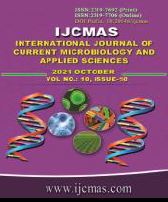


 National Academy of Agricultural Sciences (NAAS)
National Academy of Agricultural Sciences (NAAS)

|
PRINT ISSN : 2319-7692
Online ISSN : 2319-7706 Issues : 12 per year Publisher : Excellent Publishers Email : editorijcmas@gmail.com / submit@ijcmas.com Editor-in-chief: Dr.M.Prakash Index Copernicus ICV 2018: 95.39 NAAS RATING 2020: 5.38 |
Introduction: Mobile phones have become an essential part of everyday life in both healthcare and community settings. However, the widespread use of mobile phones in healthcare facilities is of concern because they can act as vehicles for transmitting pathogenic bacteria. This study aimed to investigate the bacterial contamination of mobile phones of healthcare workers (HCWs Materials and Methods: This cross-sectional study, from May to June 2018, involved 100 HCWs. The mobile phones of HCWs were swabbed for culture and antimicrobial susceptibility testing. Results: The overall prevalence of mobile phone contamination was 91%. The predominant isolates were coagulase-negative staphylococci (32.65%), Staphylococcus aureus (17%) and Bacillus spp. (11.56%). Other isolates were Micrococcus, Diptheroids, Enterococcus faecalis, Acinetobacter spp., Pseudomonas spp.,E.coli, Klebsiella sp. Most Gram-positive organisms isolates were susceptible to Linezolid, vancomycin while most of Gram-negative organisms were susceptible to piperacillin Tazobactam, Imipenam. Meticillin resistance was detected in 24% and 22.91% of S. aureus and coagulase negative staphylococci isolates, respectively. Conclusion: Mobile phones of HCWs carry potentially pathogenic bacteria and can be a source of healthcare-associated infections in healthcare settings. Hence, regulations regarding the use of mobile phones need to be developed, especially in critical areas, to reduce the dissemination of pathogenic bacteria from hands to phones and, potentially, to patients.
 |
 |
 |
 |
 |